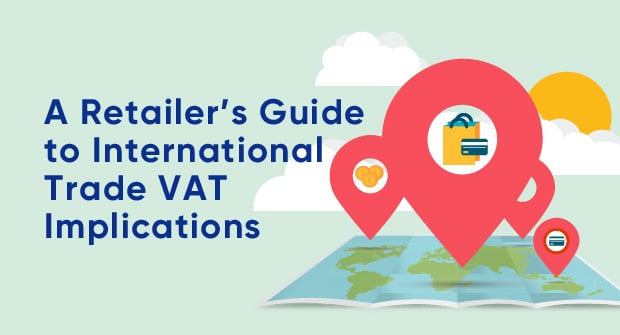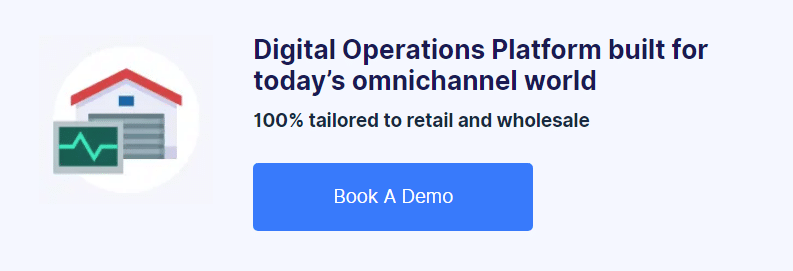A Retailer’s Guide to International Trade VAT Implications

Introduction
Over 90 million consumers from all over the world shop from merchants that are not in their country. Retailers have international trade at their fingertips, there’s a growing opportunity to reach millions of new customers overseas, which has become even more prevalent with access to marketplaces such as eBay and Amazon. E-Commerce is changing the rules of international trading, enabling retailers a less capital intense and agile way of testing and growing their businesses internationally. Whilst this opportunity is exciting retailers must also consider the implications of selling cross borders. Failure to understand and comply with local legislations can harm your business and ultimately its profitability and future.
It’s important to understand VAT when you’re considering cross border trading so you can avoid being penalised. VAT can be very complex – especially if you’re trading in multiple countries all with different VAT rules. This white paper gives you some key pointers to the implications you need to consider when trading internationally.
You’ll learn:
- VAT implications when selling
- The variables when selling to a consumer or a Business
- VAT implications when buying
- VAT rules you need to be thinking about in international trade
- And more.
Geography
For VAT purposes, the UK is defined as England, Scotland, Wales, Northern Ireland and the waters within twelve nautical miles of their coastlines.
Isle of Man
Although the Isle of Man has its own VAT authority, sales to the Isle of Man are treated as any other sale within the UK.
Channel Islands
The Channel Islands are considered to be outside the European Union (EU) and the UK for VAT purposes and sales of goods to the Channel Islands are regarded as exports. Specific documentation is needed if you export goods to The Channel Islands.
Vat implications when selling
When selling abroad, there are two variables that you need to be aware of – whether you are selling to a consumer or to a business, and whether you are selling inside or outside of the EU. The combination of these determines what you need to do.
|
|
Inside EU (Termed ‘dispatches’ or ‘removals’) |
Outside EU (Termed ‘exports’) |
|
Consumer (or non-VAT registered business) |
|
|
|
Business |
|
|
Distance Selling
If you are selling to a non-VAT registered customer in the EU and you are responsible for the delivery of the goods, this is classed as a distance sale. Each EU country has their own distance selling threshold. While you are under the threshold, you can charge UK VAT as if the sale were to a UK customer. Once you exceed the threshold, you must register for VAT separately in that EU country and charge their rate of VAT.
EC Sales Lists
EC Sales Lists (ESL) must be completed monthly or quarterly if you have made any sales to a business inside the EU that you have zero-rated. Putting a figure in box 8 on your VAT return will prompt HMRC to send you a form automatically.
You must complete an EC Sales List monthly if your EC Sales value is over £35,000 in the current quarter or the previous 4 quarters. If your sales are below this level then they are completed quarterly. If you are completing them quarterly and go over the threshold, HMRC will normally notify you that you need to start sending them monthly.
They can be submitted on paper or online. Paper forms must be submitted within 14 days of the period end and online forms within 21 days of the period end.
Unlike VAT returns, EC Sales Lists work on calendar quarters and so need to be completed for quarters ended March, June, September and December regardless of when your VAT quarter is.
Intrastat supplementary declaration
You must complete an Intrastat Supplementary Declaration if you make dispatches of more than £250,000 in a calendar year, or you have arrivals of more than £1m.
Declarations are completed monthly and the deadline for submission is 21 days after the end of the month. If you have no declaration to make for a particular month, you should send in a nil return.
The three main pieces of data included on the declaration are the commodity code, weight and country. The commodity code is an 8 digit code that is standardised across Europe for reporting purposes. If you go over a second threshold (currently £24m), then you also have to provide data about delivery terms (called Incoterms).
Some unusual situations to consider
Customer Collects Goods from the UK
If you sell to a business in the EU or to anybody outside the EU but the customer collects the goods from you in the UK, then you may still charge VAT at 0% as long as the customer gives you the evidence that the goods have left the UK. HMRC suggest that you take a deposit equal to the value of the VAT that is refunded once the evidence is received, or is kept to pay the VAT due if it is not.
Storing Goods in the EU
There are two types – ‘call off stock’ or ‘consignment stock’.
‘Call off stock’ is where you hold goods for a customer and they take delivery when they need it. Until that point, you still own the stock. As long as either the customer runs the storage facility, or knows that the goods have been delivered into storage for them, then you can still zero-rate the sale.
‘Consignment stock’ is where you send stock to another country to be held before being finally supplied to a customer. These are treated as a supply in the UK and are subject to UK VAT – unless you are also registered for VAT in the EU country in which case they can be zero-rated.
Triangulation
This is common if you are using drop-shipping and the goods never actually enter the UK – your supplier and customer are both based in the EU for example and your supplier delivers directly to your customer.
If you are registered for VAT in the UK, then you may be able to use the ’simplified procedure’ for triangulation which means that the supply to you is zero-rated and the supply to your customer is zero-rated. Triangulation must be reported on an EC Sales List, but it is not included on either your VAT return or your Intrastat Supplementary Declaration.
VAT Retail Export Scheme (RES)
The Retail Export Scheme is an optional scheme for retailers that allows them to refund VAT on goods purchased by customers in the UK who will then be taking the goods out of the EU. This is a popular scheme in tourist areas and is only available for sales to overseas visitors.
The customer must be present with the retailer when the sale is made and must complete the documentation at the retailer’s premises in full. The goods must then leave the EU within 3 months and the customer must send the retailer proof from Customs that the goods have left the EU. The retailer is only allowed to zero-rate the sale and refund the VAT amount once the proof has been received.
VAT implications when buying
|
Inside EU (Termed ‘acquisitions’)
|
Outside EU (Termed ‘imports’) |
|
In most cases, EU suppliers will be able to zero rate their supply to you in the same way that you can zero rate sales to them. In this case, entries on the VAT return are:
|
You must pay VAT at the same rate as you would have paid if the goods were bought from a UK supplier. You will normally be invoiced for this by the shipping agent at the time the goods are brought into the UK, or you can ask HMRC to set up a deferment account and pay it later. Once the VAT has been paid, HMRC will issue a C79 form. This is evidence of VAT having been paid and it can then be reclaimed on your next return. Include the VAT amount in box 4 of the VAT return. Include the value of the goods in box 7 of the VAT return. |
Deferring import VAT
Instead of having to pay VAT at the time the goods are brought into the UK, you can set up a deferment account with HMRC which allows you to pay the VAT later. It is paid on the 15th or next working day of the calendar month after the import takes place, so giving you an additional 2 – 6 weeks.
You don’t have to pay to have an account, but you must provide a bank guarantee using HMRC form C1201 and you must pay by direct debit.
Summary
The potential for expanding globally is enormous so don’t allow VAT rules and tax obligations to stand in your way of success. This white paper covers some of the key pointers to the implications you need to consider when trading internationally, however it doesn’t cover every point, and you should make sure that you always consult your accountant or HMRC if you are unsure. This paper deals only with goods and not services – there are a different set of rules for services. If you are supplying excise goods such as alcohol or tobacco, the rules are more complicated and you should take specialist advice.
Understanding the implications of selling internationally is a fundamental part of expanding your retail business internationally and compliantly. Avoid mistakes or unwanted charges and seek professional advice if you’re looking into international trade.
About the author
This guide was written by Evenstone. Evenstone have been a Brightpearl Accounting Partner since 2010. They are experts in what they do and are the outsource finance team for more than 100 businesses that use Brightpearl.
They provide as much or as little support as you need, working alongside your existing team or providing a full outsource service. The team are all fully qualified bookkeepers, passionate about making their clients’ lives easier.
Useful Links
HMRC: www.hmrc.gov.uk
HMRC have a tool to help validate whether a VAT number you have been given is valid: http://ec.europa.eu/taxation_customs/vies/vieshome.do
EU Distance Selling Thresholds: http://ec.europa.eu/taxation_customs/resources/documents/taxation/vat/traders/vat_community/vat_in_ec_annexi.pdf
Intrastat Commodity Codes: https://www.uktradeinfo.com/TradeTools/ICN/Pages/ICNBySection.aspx

